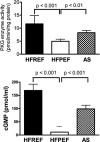The cGMP signaling pathway as a therapeutic target in heart failure with preserved ejection fraction
- PMID: 24334823
- PMCID: PMC3886746
- DOI: 10.1161/JAHA.113.000536
The cGMP signaling pathway as a therapeutic target in heart failure with preserved ejection fraction
Keywords: cGMP; heart failure; phosphodiesterase 5; preserved ejection fraction; soluble guanylate cyclase.
Figures




Similar articles
-
cGMP Signaling and Modulation in Heart Failure.J Cardiovasc Pharmacol. 2020 May;75(5):385-398. doi: 10.1097/FJC.0000000000000749. J Cardiovasc Pharmacol. 2020. PMID: 31464774 Free PMC article. Review.
-
Multiplicity of Nitric Oxide and Natriuretic Peptide Signaling in Heart Failure.J Cardiovasc Pharmacol. 2020 May;75(5):370-384. doi: 10.1097/FJC.0000000000000724. J Cardiovasc Pharmacol. 2020. PMID: 31498237 Review.
-
Therapeutic Stalemate in Heart Failure With Preserved Ejection Fraction.J Am Heart Assoc. 2021 Jun 15;10(12):e021120. doi: 10.1161/JAHA.121.021120. Epub 2021 May 31. J Am Heart Assoc. 2021. PMID: 34056916 Free PMC article. Review.
-
Novel sGC Stimulators and sGC Activators for the Treatment of Heart Failure.Handb Exp Pharmacol. 2017;243:225-247. doi: 10.1007/164_2016_100. Handb Exp Pharmacol. 2017. PMID: 27900610 Review.
-
Leveraging Signaling Pathways to Treat Heart Failure With Reduced Ejection Fraction.Circ Res. 2019 May 24;124(11):1618-1632. doi: 10.1161/CIRCRESAHA.119.313682. Circ Res. 2019. PMID: 31120818 Free PMC article. Review.
Cited by
-
Inhibitory effect of (pro)renin receptor decoy inhibitor PRO20 on endoplasmic reticulum stress during cardiac remodeling.Front Pharmacol. 2022 Aug 12;13:940365. doi: 10.3389/fphar.2022.940365. eCollection 2022. Front Pharmacol. 2022. PMID: 36034809 Free PMC article.
-
Targeting Cyclic Guanylate Monophosphate in Resistant Hypertension and Heart Failure: Are Sacubitril/Valsartan and Vericiguat Synergistic and Effective in Both Conditions?High Blood Press Cardiovasc Prev. 2021 Nov;28(6):541-545. doi: 10.1007/s40292-021-00489-z. Epub 2021 Nov 9. High Blood Press Cardiovasc Prev. 2021. PMID: 34750764 No abstract available.
-
Drugs' development in acute heart failure: what went wrong?Heart Fail Rev. 2018 Sep;23(5):667-691. doi: 10.1007/s10741-018-9707-y. Heart Fail Rev. 2018. PMID: 29736812 Review.
-
Treatment With Treprostinil and Metformin Normalizes Hyperglycemia and Improves Cardiac Function in Pulmonary Hypertension Associated With Heart Failure With Preserved Ejection Fraction.Arterioscler Thromb Vasc Biol. 2020 Jun;40(6):1543-1558. doi: 10.1161/ATVBAHA.119.313883. Epub 2020 Apr 9. Arterioscler Thromb Vasc Biol. 2020. PMID: 32268788 Free PMC article.
-
Pro-Atrial Natriuretic Peptide: A Novel Guanylyl Cyclase-A Receptor Activator That Goes Beyond Atrial and B-Type Natriuretic Peptides.JACC Heart Fail. 2015 Sep;3(9):715-23. doi: 10.1016/j.jchf.2015.03.015. JACC Heart Fail. 2015. PMID: 26362447 Free PMC article.
References
-
- Owan TE, Hodge DO, Herges RM, Jacobsen SJ, Roger VL, Redfield MM. Trends in prevalence and outcome of heart failure with preserved ejection fraction. N Engl J Med. 2006; 355:251-259 - PubMed
-
- Steinberg BA, Zhao X, Heidenreich PA, Peterson ED, Bhatt DL, Cannon CP, Hernandez AF, Fonarow GC. Trends in patients hospitalized with heart failure and preserved left ventricular ejection fraction: prevalence, therapies, and outcomes. Circulation. 2012; 126:65-75 - PubMed
-
- Bhatia RS, Tu JV, Lee DS, Austin PC, Fang J, Haouzi A, Gong Y, Liu PP. Outcome of heart failure with preserved ejection fraction in a population‐based study. N Engl J Med. 2006; 355:260-269 - PubMed
-
- Shah RV, Desai AS, Givertz MM. The effect of renin‐angiotensin system inhibitors on mortality and heart failure hospitalization in patients with heart failure and preserved ejection fraction: a systematic review and meta‐analysis. J Card Fail. 2010; 16:260-267 - PubMed
Publication types
MeSH terms
Substances
LinkOut - more resources
Full Text Sources
Other Literature Sources
Medical

